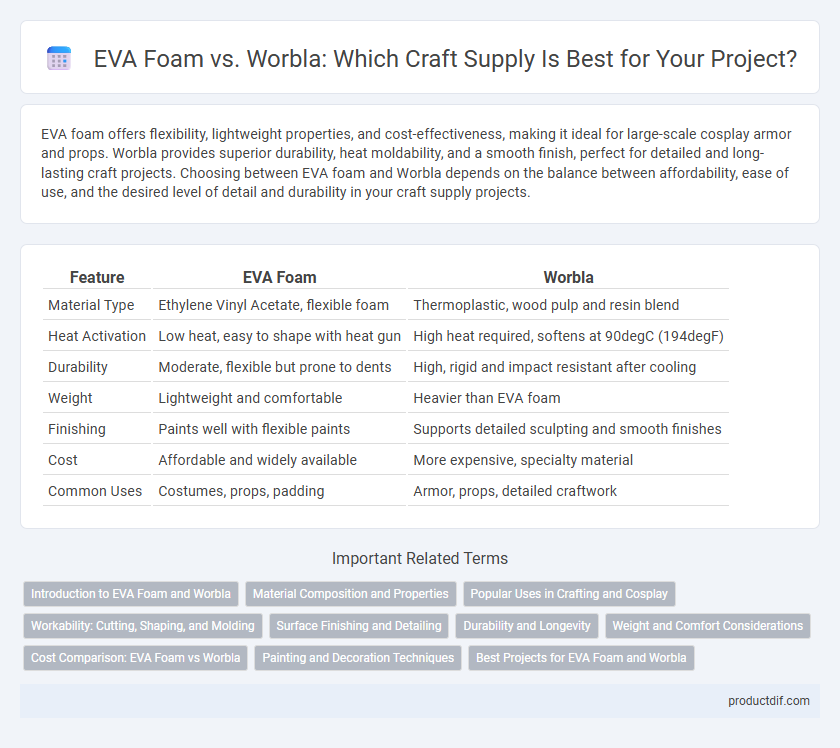EVA foam offers flexibility, lightweight properties, and cost-effectiveness, making it ideal for large-scale cosplay armor and props. Worbla provides superior durability, heat moldability, and a smooth finish, perfect for detailed and long-lasting craft projects. Choosing between EVA foam and Worbla depends on the balance between affordability, ease of use, and the desired level of detail and durability in your craft supply projects.
Table of Comparison
| Feature | EVA Foam | Worbla |
|---|---|---|
| Material Type | Ethylene Vinyl Acetate, flexible foam | Thermoplastic, wood pulp and resin blend |
| Heat Activation | Low heat, easy to shape with heat gun | High heat required, softens at 90degC (194degF) |
| Durability | Moderate, flexible but prone to dents | High, rigid and impact resistant after cooling |
| Weight | Lightweight and comfortable | Heavier than EVA foam |
| Finishing | Paints well with flexible paints | Supports detailed sculpting and smooth finishes |
| Cost | Affordable and widely available | More expensive, specialty material |
| Common Uses | Costumes, props, padding | Armor, props, detailed craftwork |
Introduction to EVA Foam and Worbla
EVA Foam is a lightweight, flexible, and durable craft material widely used for cosplay armor, props, and costume details due to its ease of cutting, shaping, and painting. Worbla, a thermoplastic material, becomes moldable when heated, allowing crafters to create intricate, rigid structures with a smooth finish ideal for detailed costume parts and accessories. Both materials offer unique benefits for crafting, with EVA Foam preferred for larger, lightweight pieces and Worbla for fine, durable details.
Material Composition and Properties
EVA foam, made from ethylene-vinyl acetate copolymer, is lightweight, flexible, and highly durable, making it ideal for crafting detailed costume pieces and props. Worbla consists of thermoplastic resin with wood flour and is reactive to heat, allowing it to soften and mold into intricate shapes while hardening upon cooling for rigid, durable structures. The closed-cell structure of EVA provides cushioning and shock absorption, whereas Worbla's plastic composition offers superior strength and paint adhesion for long-lasting finishes.
Popular Uses in Crafting and Cosplay
EVA foam is widely favored for cosplay due to its lightweight, flexible nature and ease of cutting and shaping, making it ideal for creating costume armor, props, and intricate details. Worbla, a thermoplastic material, is popular for its moldability when heated, allowing crafters to sculpt durable, smooth surfaces perfect for high-detail, structural elements and accessories. Both materials are essential in crafting and cosplay, with EVA foam excelling in comfort and volume, while Worbla offers strength and refined finishes for professional-grade costumes.
Workability: Cutting, Shaping, and Molding
EVA foam offers exceptional workability due to its lightweight, flexible nature, allowing for easy cutting, shaping with heat, and molding into intricate designs. Worbla, a thermoplastic material, becomes pliable when heated, enabling precise molding and sculpting but requires higher temperatures and more skill for detailed cuts and adjustments. Both materials excel in craft projects, with EVA ideal for quick, versatile manipulation, while Worbla provides durable, smooth finishes suited for complex forms.
Surface Finishing and Detailing
EVA foam offers a smooth, flexible surface ideal for easy shaping and sanding, making it perfect for crafting detailed costumes and props with a refined finish. Worbla features a thermoplastic surface that can be intricately molded and sculpted, allowing for precise texturing and sharp, durable details after cooling. Both materials support various paint applications, but Worbla's hard surface holds fine details better, while EVA foam provides a lighter, more pliable base for layered surface effects.
Durability and Longevity
EVA foam offers high durability with excellent flexibility, making it resistant to cracking and ideal for lightweight cosplay armor that endures frequent wear. Worbla, a thermoplastic material, provides superior longevity due to its rigid structure and the ability to be reheated and reshaped, offering a more solid and robust finish for long-lasting craft projects. While EVA foam excels in impact resistance and comfort, Worbla's durability is enhanced by its toughness and ability to maintain shape under stress, making both materials valuable depending on the durability needs of the project.
Weight and Comfort Considerations
EVA foam is lightweight and flexible, making it ideal for comfortable, extended wear in costume and prop crafting. Worbla, while heavier and more rigid, provides superior durability and detail retention, but may cause fatigue during long usage. Choosing between EVA foam and Worbla depends on balancing comfort for prolonged wear against the desired structural strength and finish quality.
Cost Comparison: EVA Foam vs Worbla
EVA foam typically costs between $5 to $15 per sheet depending on thickness and size, making it a budget-friendly option for large projects and cosplay armor. Worbla, a thermoplastic material, is significantly more expensive at around $25 to $40 per sheet, reflecting its higher durability and ease of molding. Choosing between EVA foam and Worbla depends on balancing initial material costs with desired finish quality and project longevity.
Painting and Decoration Techniques
EVA foam offers a smooth, porous surface ideal for acrylic paints and can be sealed with Plasti Dip or Mod Podge to enhance paint adhesion and durability. Worbla, a thermoplastic material, requires priming with materials like gesso or wood glue before painting to prevent paint peeling, making it excellent for intricate details and textured finishes. Both materials accept various decoration techniques including airbrushing, dry brushing, and weathering, but Worbla provides a more rigid base for fine sculptural work, while EVA foam remains lightweight and flexible.
Best Projects for EVA Foam and Worbla
EVA foam excels in cosplay armor, props, and lightweight costume details due to its flexibility, ease of cutting, and heat-forming capabilities. Worbla is ideal for intricate designs, detailed sculpting, and durable, form-fitting pieces that require thermoforming and layering. Projects requiring high durability and fine detail often benefit from Worbla, while large, wearable, and budget-friendly creations favor EVA foam.
EVA Foam vs Worbla Infographic

 productdif.com
productdif.com